The Plant
Habitat - Flowers - Measuring Acceleration - Why Explosions? - Beetle FrassGlobal Distribution
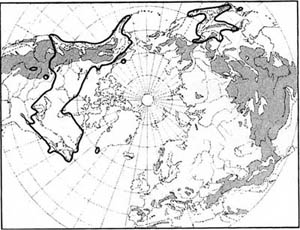
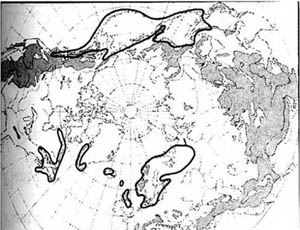 Global Distribution of Cornus canadensis (left) and Cornus suecica (right).
Global Distribution of Cornus canadensis (left) and Cornus suecica (right).
Bunchberry dogwood (Cornus canadensis) and its sister species, the Swedish Cornel (Cornus suecica) both have flowers that bloom explosively. They are found around the world in the vast taiga of the northern hemisphere. In North America, bunchberry grows coast to coast in Canada and the Northern United States. It extends along the mountaintops as far south as Virginia in the east and New Mexico in the west.
Habitat
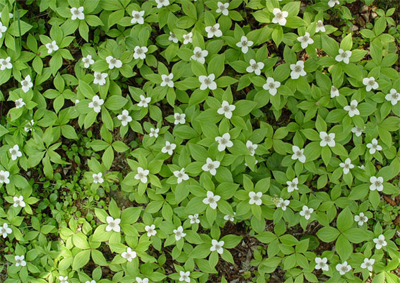 A Field of Dogwood
A Field of Dogwood
Bunchberry dogwood is a subshrub where the above ground portions of the plant form large clones that carpet the forest floor. The flowering shoots often cover large areas with up to 300 flowering shoots per square meter. With an average of 22 flowers per shoot, bunchberry often has 6,600 flowers in one square meter.
Flowers
The tiny flowers of Cornus canadensis are arranged in inflorescences of 20-50 flowers, which are subtended by four showy white bracts. Bracts are often mistaken for petals – but are actually modified showy leaves. The inflorescence above has 30 flowers. Three flowers are open and appear dark because the deep purple nectar disc is visible once flowers open. Seven flowers are mature and look like an "x" because the filaments of the four stamens protrude from between the petals. The remaining flowers are still developing. Mature flowers are ready to explode and measure approximately 2 mm across.
 Four fused petals of the flower.
Four fused petals of the flower.
Each flower has four petals, which are connected to each other only at the tip. The petals restrain the four stamens that are bent in the bud and store elastic energy used to launch pollen. Each stamen consists of a filament with a pollen-containing anther sac attached with a hinge to the filament tip. The anther sacs dehisce or split open before the flower blooms and are ready to propel pollen as soon as the flower is triggered open.
Above we show two images of a mature flower. In the left image the flower is closed with petals fused at the tips and the stamen filaments bent and protruding from between the petals. One petal has a trigger. In the right image, the flower has exploded and released most of its pollen. The stamens extended up and the petals are completely bent back or reflexed.
Measuring Acceleration and Velocity
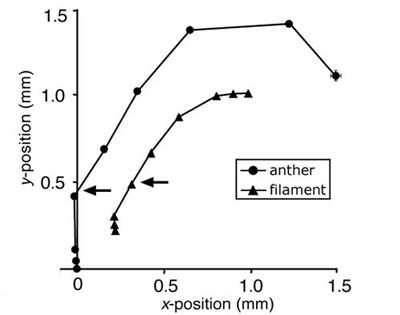 Position mappings for anther and filament tips.
Position mappings for anther and filament tips.
By using stills from the high-speed videos we could measure the distances moved in a given time interval. In the pictures above the dots in the left-hand picture show the position of the top of the filament at successive 0.1ms intervals; the dots in the right-hand picture show the position of the tip of the anther sac at successive 0.1ms intervals. Velocity values were obtained by measuring the change in position for each interval and acceleration values were derived from the difference in successive velocity measurements.
Because the anther sac is connected to the filament by a hinge, it is free to rotate about the filament tip. Consequently the motion of the pollen held within it is different than the filament's. From the figure one can see that the anthers accelerate straight upwards for a longer period than the filament tips. This increased time of vertical acceleration allows the anther to maximize its vertical speed before the pollen is released via the sideways motion. An increased launch speed translates directly into a more powerful release of pollen.
Why Have Exploding Flowers?
Exploding flowers may enhance insect pollination and also allow for pollination by wind, should there be no insects.
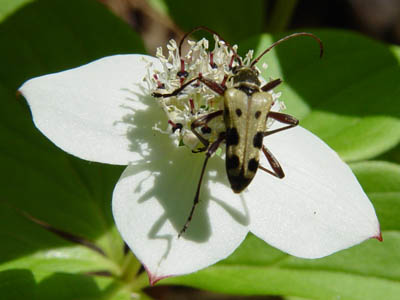 A Long-horn beetle on an inflorescence.
A Long-horn beetle on an inflorescence.
Insect Pollination. A wide variety of insects visit bunchberry flowers from tiny ants to medium sized long-horn beetles (in image above) to very large queen bumblebees. Exploding flowers may enhance insect pollination in two ways. First, exploding flowers limits pollinators to those insects that are heavy enough to trigger open the flowers. Large insects readily move between inflorescences whereas smaller insects (e.g., ants and small flies) are ineffective pollinators because they rarely move between inflorescences. Second, most of the large insects are voracious pollen eaters. The explosive flowering disperses the pollen over the body of the insects and imbeds it deep in their hairs where it is hard for them to gather it to eat.
 Pollen print in a still room.
Pollen print in a still room.
Wind Pollination. In the absence of insect visitors, exploding flowering may allow for pollination by wind. Increasingly, we are discovering that flowers have more than one method of pollination. For bunchberry, pollen can be carried even on very light currents in a still room (see the pollen print above where the pollen was carried >22cm). In the field with strong winds, the pollen was carried over a meter.
Beetle Frass
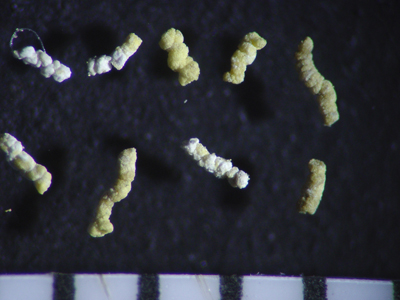 Long-horn beetle frass
Long-horn beetle frass
Frass (droppings) from the long-horn beetle, Evodinus monticola (shown on an inflorescence above). The scale below gives 1mm increments. The yellow patches are mostly crushed pollen grains. Pollen is a rich source of proteins, starches, sugars and fats. The image below shows beetle frass magnified even further. You can clearly see the crushed pollen grains (gray arrows). Beetles destroy much of the pollen they eat. Pollen grains are about 22 microns in diameter.
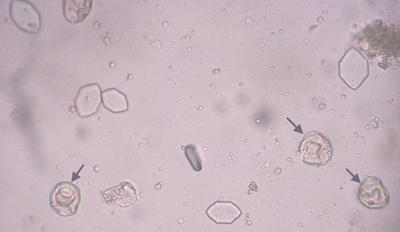 Dogwood pollen in the beetle frass
Dogwood pollen in the beetle frass
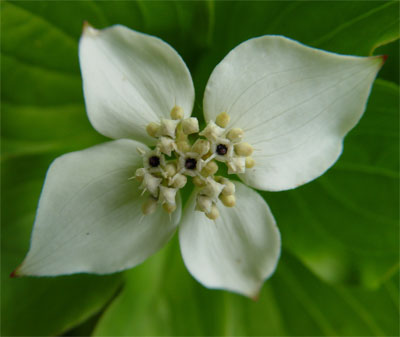 (click
(click  (click
(click